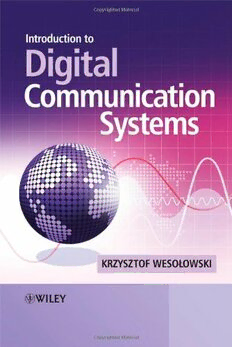Download Introduction to Digital Communication Systems PDF Free - Full Version
Download Introduction to Digital Communication Systems by Krzysztof Wesolowski in PDF format completely FREE. No registration required, no payment needed. Get instant access to this valuable resource on PDFdrive.to!
About Introduction to Digital Communication Systems
Preface. About the Author. 1 Elements of Information Theory. 1.1 Introduction. 1.2 Basic Concepts. 1.3 Communication System Model. 1.4 Concept of Information and Measure of Amount of Information. 1.5 Message Sources and Source Coding. 1.6 Discrete Source Coding. 1.7 Channel Models from the Information Theory Point of View. 1.8 Mutual Information. 1.9 Properties of Mutual Information. 1.10 Channel Capacity. 1.11 Decision Process and its Rules. 1.12 Differential Entropy and Average Amount of Information for Continuous Variables. 1.13 Capacity of Band-Limited Channel with Additive White Gaussian Noise. 1.14 Implication of AWGN Channel Capacity for Digital Transmission. 1.15 Capacity of a Gaussian Channel with a Given Channel Characteristic. 1.16 Capacity of a Flat Fading Channel. 1.17 Capacity of a Multiple-Input Multiple-Output Channel. Problems. 2 Channel Coding. 2.1 Idea of Channel Coding. 2.2 Classification of Codes. 2.3 Hard- and Soft-Decision Decoding. 2.4 Coding Gain. 2.5 Block Codes. 2.6 Nonalgebraic Decoding for Block Codes. 2.7 Algebraic Decoding Methods for Cyclic Codes. 2.8 Convolutional Codes and Their Description. 2.9 Convolutional Code Decoding. 2.10 Concatenated Coding. 2.11 Case Studies: Two Examples of Concatenated Coding. 2.12 Turbo Codes. 2.13 LDPC Codes. 2.14 Error Detection Structures and Algorithms. 2.15 Application of Error Detection - ARQ Schemes. 2.16 Hybrid ARQ. Problems. 3 Digital Baseband Transmission. 3.1 Introduction. 3.2 Shaping of Elementary Signals. 3.3 Selection of the Data Symbol Format. 3.4 Optimal Synchronous Receiver. 3.5 Error Probability at the Output of the Optimal Synchronous Receiver. 3.6 Error Probability in the Optimal Receiver for M -PAM Signals. 3.7 Case Study: Baseband Transmission in Basic Access ISDN Systems. 3.8 Appendix: Power Spectral Density of Pulse Sequence. Problems. 4 Digital Modulations of the Sinusoidal Carrier. 4.1 Introduction. 4.2 Optimal Synchronous Receiver. 4.3 Optimal Asynchronous Receiver. 4.4 ASK Modulation. 4.5 FSK Modulation. 4.6 PSK Modulation. 4.7 Linear Approach to Digital Modulations - M -PSK Modulation. 4.8 Differential Phase Shift Keying (DPSK). 4.9 Digital Amplitude and Phase Modulations - QAM. 4.10 Constant Envelope Modulations - Continuous Phase Modulation (CPM). 4.11 Trellis-Coded Modulations. 4.12 Multitone Modulations. 4.13 Case Study: OFDM Transmission in DVB-T System. 4.14 Influence of Nonlinearity on Signal Properties. Problems. 5 Properties of Communication Channels. 5.1 Introduction. 5.2 Baseband Equivalent Channel. 5.3 Telephone Channel. 5.4 Properties of a Subscriber Loop Channel. 5.5 Line-of-Sight Radio Channel. 5.6 Mobile Radio Channel. 5.7 Examples of Other Radio Channels. 5.8 Basic Properties of Optical Fiber Channels. 5.9 Conclusions. Problems. 6 Digital Transmission on Channels Introducing Intersymbol Interference. 6.1 Introduction. 6.2 Intersymbol Interference. 6.3 Channel with ISI as a Finite State Machine. 6.4 Classification of Equalizer Structures and Algorithms. 6.5 Linear Equalizers. 6.6 Decision Feedback Equalizer. 6.7 Equalizers using MAP Symbol-by-Symbol Detection. 6.8 Maximum Likelihood Equalizers. 6.9 Examples of Suboptimum Sequential Receivers. 6.10 Case Study: GSM Receiver. 6.11 Equalizers for Trellis-Coded Modulations. 6.12 Turbo Equalization. 6.13 Blind Adaptive Equalization. 6.14 Equalizers for MIMO Systems. 6.15 Conclusions. Problems. 7 Spread Spectrum Systems. 7.1 Introduction. 7.2 Pseudorandom Sequence Generation. 7.3 Direct Sequence Spread Spectrum Systems. 7.4 RAKE Receiver. 7.5 Frequency-Hopping Spread Spectrum Systems. 7.6 Time-Hopping Spread Spectrum System with Pseudorandom Pulse Position Selection. Problems. 8 Synchronization in Digital Communication Systems. 8.1 Introduction. 8.2 Phase-locked loop for continuous signals. 8.3 Phase-Locked Loop for Sampled Signals. 8.4 Maximum Likelihood Carrier Phase Estimation. 8.5 Practical Carrier Phase Synchronization Solutions. 8.6 Timing Synchronization. Problems. 9 Multiple Access Techniques. 9.1 Introduction. 9.2 Frequency Division Multiple Access. 9.3 Time Division Multiple Access. 9.4 Code Division Multiple Access. 9.5 Orthogonal Frequency Division Multiple Access. 9.6 Single-Carrier FDMA. 9.7 Space Division Multiple Access. 9.8 Case Study: Multiple Access Scheme in the 3GPP LTE Cellular System. 9.9 Conclusions. Problems. Appendix. Bibliography. Index
Detailed Information
| Author: | Krzysztof Wesolowski |
|---|---|
| Publication Year: | 2009 |
| ISBN: | 470695196 |
| Pages: | 579 |
| Language: | English |
| File Size: | 4.013 |
| Format: | |
| Price: | FREE |
Safe & Secure Download - No registration required
Why Choose PDFdrive for Your Free Introduction to Digital Communication Systems Download?
- 100% Free: No hidden fees or subscriptions required for one book every day.
- No Registration: Immediate access is available without creating accounts for one book every day.
- Safe and Secure: Clean downloads without malware or viruses
- Multiple Formats: PDF, MOBI, Mpub,... optimized for all devices
- Educational Resource: Supporting knowledge sharing and learning
Frequently Asked Questions
Is it really free to download Introduction to Digital Communication Systems PDF?
Yes, on https://PDFdrive.to you can download Introduction to Digital Communication Systems by Krzysztof Wesolowski completely free. We don't require any payment, subscription, or registration to access this PDF file. For 3 books every day.
How can I read Introduction to Digital Communication Systems on my mobile device?
After downloading Introduction to Digital Communication Systems PDF, you can open it with any PDF reader app on your phone or tablet. We recommend using Adobe Acrobat Reader, Apple Books, or Google Play Books for the best reading experience.
Is this the full version of Introduction to Digital Communication Systems?
Yes, this is the complete PDF version of Introduction to Digital Communication Systems by Krzysztof Wesolowski. You will be able to read the entire content as in the printed version without missing any pages.
Is it legal to download Introduction to Digital Communication Systems PDF for free?
https://PDFdrive.to provides links to free educational resources available online. We do not store any files on our servers. Please be aware of copyright laws in your country before downloading.
The materials shared are intended for research, educational, and personal use in accordance with fair use principles.

